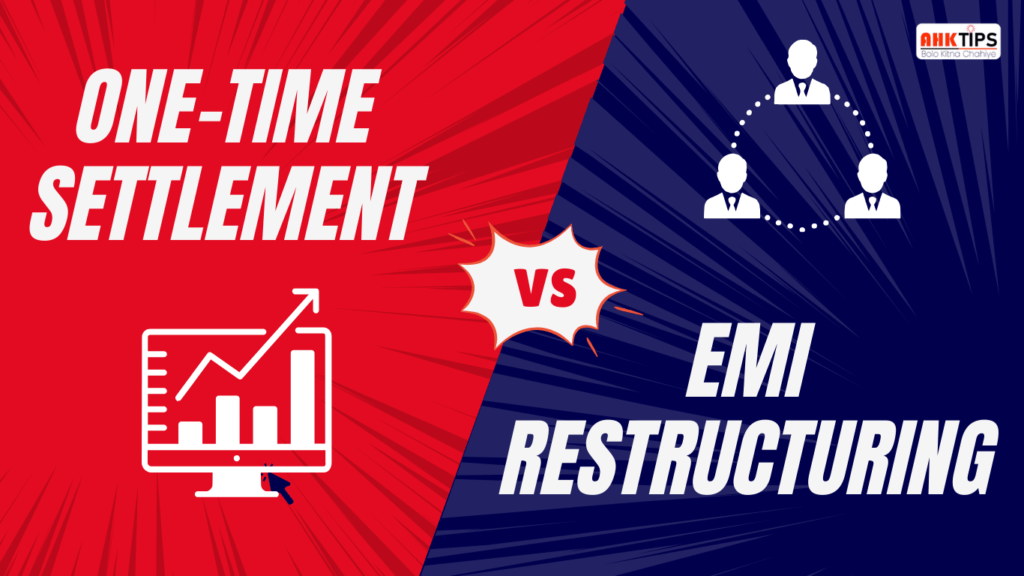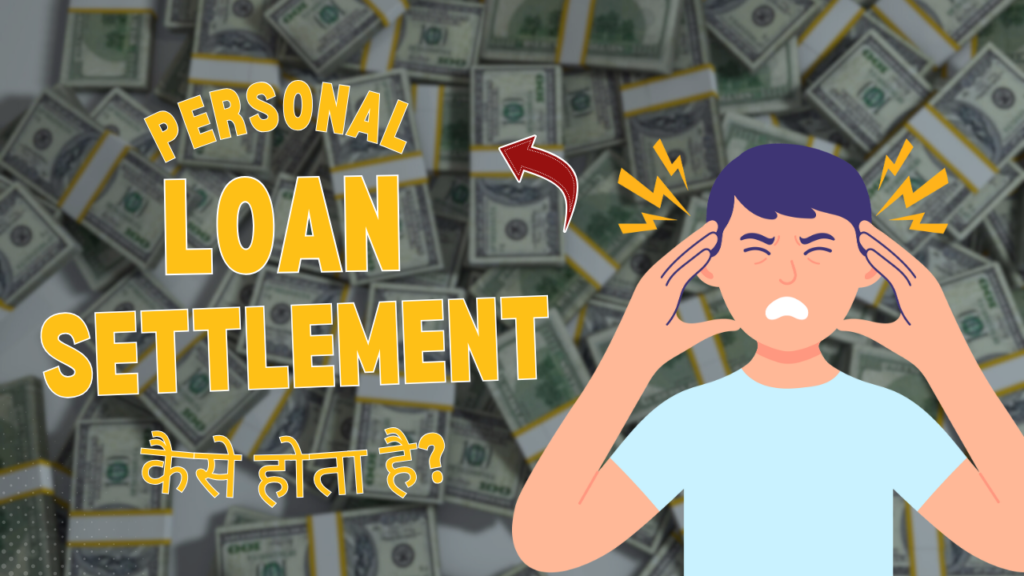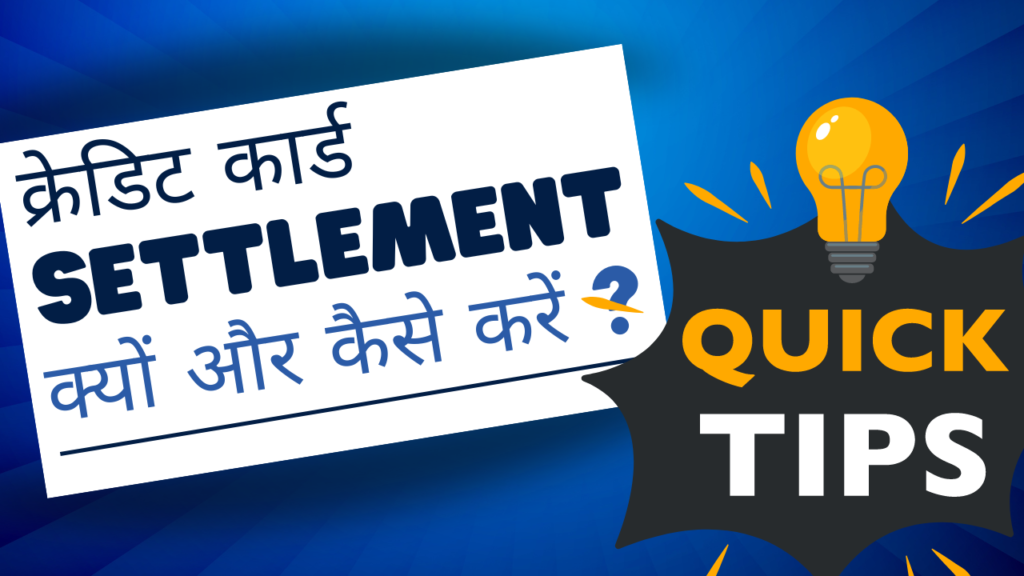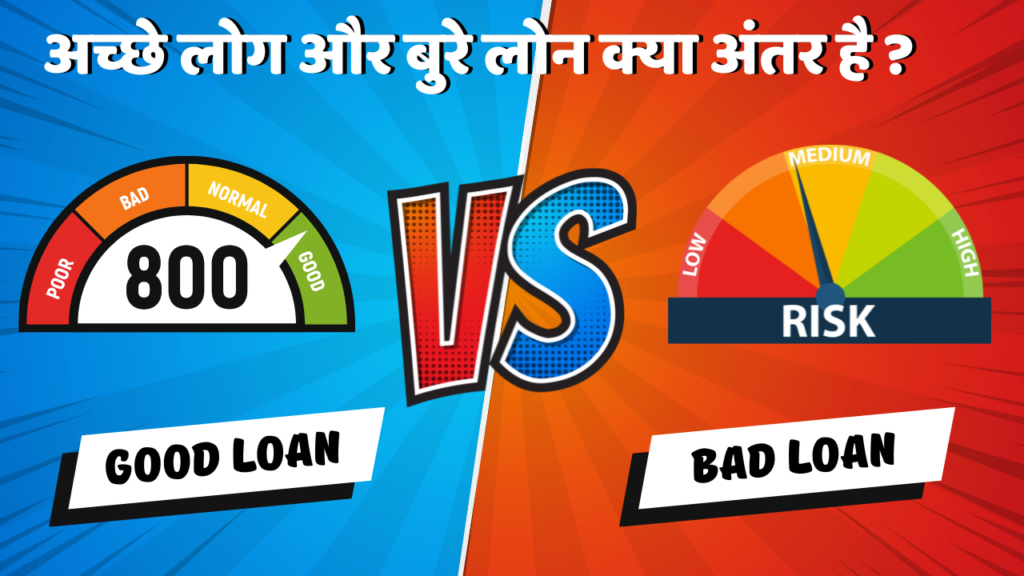Summary
Borrowers in financial difficulty have options for debt management between loan settlement and EMIs restructuring. Paying a lump sum less than the total owing is known as loan settlement; the lender notes the loan as “settled.” This seriously lowers your credit score and reduces future loan eligibility. Usually, it’s a final resort when one cannot pay back. By contrast, EMI restructuring changes your repayment terms—that is, either lengthens the loan term or lowers monthly payments—without lowering the overall amount owing. It is suitable for transient financial difficulties and helps maintain your credit score. Settlement compromises credit, even if it provides instant comfort. Restructuring preserves creditworthiness over the long term. Before you decide, always evaluate your circumstances and talk to your lender. Choose a settlement only if there are no other choices left.
Introduction
Managing loan repayments could prove difficult in times of financial crisis, including job loss, medical issues, or lower income. Under these circumstances, banks often provide two relief options: E MI restructuring and loan settlement. Although they both try to lighten your load, they have somewhat distinct effects on your credit score. EMI restructuring changes the conditions of your loan to make monthly payments more reasonable; loan settlement involves negotiating with the lender to accept a smaller lump sum payment. Deciding between them affects your creditworthiness, financial future, and capacity to borrow once more, not only about temporary relief. This article details the advantages and drawbacks of every alternative, together with how to choose which best fits your financial situation. Making any decision requires first an awareness of the differences.
Difference Between Loan Settlement and EMI Restructuring
Numerous debtors look for ways to manage their debt without completely defaulting while they are experiencing financial hardship. Banks tend to offer two options: loan settlement and EMI restructuring. While both aim to lighten your financial burden, their implications on your credit score and financial future vary, and they work pretty differently.
Before deciding on a solution, one needs to be aware of the differences between loan settlement and EMIs restructuring. Let’s consider both their strengths and weaknesses, how they work, and how to best decide which would suit your situation.
What Is Loan Settlement?
Debt settlement, also known as loan settlement, is the process where a lender forgoes accepting a lump sum payment less than the amount outstanding in the loan, hence making the loan “settled.”
How Loan Settlement Works
In case a major financial catastrophe like job loss, medical crisis, or business failure renders you incapable of repaying your loan, the lender can agree to a one-time settlement. Typically given after a series of missed EMIs, it depends on the lender’s perception that legal recovery may take longer.
The bank forgives the balance payment; it takes on some of the entire debt. After paying, your credit report indicates the loan as “settled,” but not as “closed.”
Effect of Loan Settlement
Your credit rating drops significantly after a settlement.
Your credit report indicates the status of “settled” for as long as seven years, and that reduces your chances of getting credit cards or loans in the future.
- Lenders regard it as proof of your unsuccessful attempt to repay the loan schedule.
- When Loan Settlement Could Be Used
- You are in financial trouble.
- On certain EMIs, you have previously defaulted.
- You are not able to sustain regular repayment.
What Is EMI Restructuring?
EMI restructuring is a formal process by which the bank alters the terms of your loan to enable repayment. This may require increasing the loan term, reducing the EMI, or giving it a temporary moratorium.
How EMI Restructuring Works
EMI restructuring is for borrowers who are still financially active but temporarily experiencing cash flow issues. You continue to repay the entire amount in the long term, but under more agreeable terms now.
Your EMI each month would be reduced, for example, if your loan period were increased from five to seven years. The bank could, on the other hand, grant you a grace period of three to six months before repayment.
Effect of Restructuring EMI
You are not in default, and therefore your credit rating is virtually unaffected.
- Your credit report reflects the loan as “restructured,” which is not viewed as negatively as “settled.”
- The extended period will result in you paying a little more interest over the long run.
When EMI Restructuring May be Worth Considering
- You continue to work or earn a regular income.
- You believe your financial issues will be temporary.
- Your credit history is something you’d like to maintain.
Key Differences Between Loan Settlement and EMI Restructuring
Credit Score Effect
As you are not settling the full sum, the loan settlement drastically decreases your credit score. The “settled” terminology puts out big warning signs to future borrowers.
Restructuring of EMI has a smaller impact. You are still fulfilling your financial obligation even if the loan has been restructured.
Loan Status in Credit Report
Closed loans are different from settled loans. “Settled” means partial repayment.
Your report mentions a restructured loan, but it indicates you are still making payments, just under altered terms.
Eligibility Criteria
Typically offered after default or when recovery appears unlikely is loan settlement. It presents a last-resort option.
EMI restructuring is recommended prior to default, particularly if you take active steps to inform the lender about your situation.
Future Loan Approval
Most banks will not give new credit for many years after debt repayment. Increased lending rates and growing monitoring will also be challenges.
Future lenders may, however, consider you for EMI restructuring, especially if your payment history remains good after the restructuring.
Repayment Structure
Loan settlement is a lump sum payment that should tie things up. It may require quick arrangement of a substantial amount.
EMI restructuring allows you to retain monthly payments, scaled down to suit your finances.
Loan Settlement vs. EMI Restructuring
Before deciding on either of these choices, give your financial situation much thought. EMI reorganisation is the better course of action if your circumstances are transient and controllable with a changed strategy. It maintains your loan record clear and guards your credit score.
Conversely, loan settlement could assist you in cancelling the loan, even if it would damage your credit history, if you are unable to pay and have run out of other choices.
Final Thoughts on the Difference Between Loan Settlement and EMI Restructuring
Loan settlement and EMI restructuring differ mostly in your capacity and willingness to pay back. One compromises your creditworthiness; the other provides a means of recovery free from long-term damage. Before deciding, always consult with your lender or a financial adviser; attempt to avoid settlement unless required.
Tell me whether you want a meta title and description for improved visibility or whether you would want to post this item on your website.
Pros and Cons of Loan Settlement and Restructuring
Two options typically offered by banks while dealing with financial duress, particularly due to loan repayment issues, are debt settlement and EMI restructuring. Although they work differently and impact your credit score in varying ways, both are debt relief options.
Knowing the advantages and disadvantages of debt settlement and restructuring can assist you in determining which is more suitable for your situation before committing to anything.
What Is Loan Settlement?
Loan settlement is an agreement where the borrower settles a lower amount in a lump sum to settle the loan under the agreement between him and the lender. The lender records the debt as “settled” on credit reports after forgiving the outstanding balance.
Advantages of Loan Settlement
Instant Relief from Debt Burden
A quick way out of a demanding loan situation is loan settlement. After paying for and receiving the settlement, you are no longer required to continue monthly payments.
Prevents Legal Action
In case your account is already in default, loan settlement will prevent you from facing lender legal battles or collection proceedings.
Choice for Extreme Financial Crisis
If you have neither income nor assets to repay the entire sum and the financial hardship is either long-term or permanent, loan settlement may be an appropriate option.
Drawbacks of Loan Settlement
Adverse Effect on Credit Score
The worst part is the fall in your credit score. Your creditworthiness is devalued by the “settled” notation on your credit report showing partial payment of the loan.
Difficulty in Obtaining Future Loans
Banks may view you as a risky borrower after settlement. You may be rejected for loans or charged high interest rates in the future.
One-Time Payment Requirement
Most of the time, you are required to make a single payment of cash to settle the debt. For most borrowers, coming up with this money quickly can be challenging.
What Is EMI Restructuring?
EMI restructuring is the process where the lender alters the original loan repayment terms. This may include providing temporary relief from repayments, reducing EMI sizes, or extending the loan duration.
Advantages of EMI Restructuring
Maintains Credit Score
Your credit rating remains quite stable as you continue to repay the entire loan amount even in altered situations. The loan is termed as “restructured,” but not as “defaulted” or “settled.”
Flexible Repayment Terms
Restructuring assists you in lowering your EMI burden, especially in situations of a temporary reduction in income. It provides leeway without cancelling the loan abruptly.
Saves Relationship with Lender
Typically, restructuring means being cooperative with the bank. It improves your image as a responsible borrower who wishes to repay, which will work in your favour for future loan sanctions.
Drawbacks of EMI Restructuring
Higher Total Interest
Although stretching the period may reduce your monthly EMI, it will increase the total interest paid during the life of the loan.
Potential Temporary Credit Flag
Though restructuring is less damaging than settlement, it is still reported on your credit report. Some lenders may view restructured loans with distrust in the future.
Needs Lender’s Approval
Not all requests for restructuring are authorized. You must meet the lender’s policy and may need to produce documentation substantiating income disruption or adversity.
Comparing the Advantages and Drawbacks of Loan Settlement and Restructuring
Financial Impact
The settlement of a loan hurts your credit report, although it reduces the overall burden. Restructuring of EMI enables you to cope with your debt more effectively, so maintaining your credit profile, although it does not decrease it.
Credit Report and Score
For as long as seven years, a settlement creates a long-term negative trace in your credit report. Restructuring will have a short-term effect, and as long as you pay regularly, it will not significantly decrease your score.
Suitability
For those borrowers facing extreme financial crises with no reasonable repayment capacity, loan settlement is preferable. For those financially engaged but requiring time or changes to stabilize, EMI restructuring may be just perfect.
Repayment Flexibility
Whereas restructuring provides ongoing flexibility with lesser EMIs or relief for a temporary period, loan settlement is a final closure with one lump sum.
Long-Term Consequences
Settlement has long-term effects, such as restricted access to new credit and having to start rebuilding your credit record from scratch. Restructuring enables you to manage short-term issues and remain on track towards your financial objectives.
Making the Right Choice
Your financial circumstances and future objectives will dictate whether restructuring and settlement are a benefit or a vice. Restructuring is the more credit-friendly and safe option if you can continue to pay with adjustments. Settlement must only be pursued with knowledge of its repercussions; only when repayment is completely impossible might it be a measure of last resort.
How to Negotiate Loan Restructuring or Settlement
No one is immune to money troubles; when they happen, you have to act quickly. If you find yourself in a position where you cannot repay a loan, your two best options may be either settling or restructuring the deal. Both are methods to prevent default and reduce stress, but to be able to use them to your advantage, you need to be skilled at negotiating loan restructuring or settlement.
Negotiating directly with your lender can help you reduce the financial impact and ensure improved terms. This book will guide you through achievable steps to prepare, communicate, and achieve results.
Understand the Basics Before You Negotiate
It is essential to be aware of the distinction between settlement and restructuring before you meet with your lender.
What Is Loan Restructuring?
Loan restructuring is a modification to the existing terms aimed at facilitating more manageable repayment. This may mean a reduced EMI, extended loan period, or a temporary relief such as a pay stop.
What Is Loan Settlement
The payment of part of your current debt under an agreement of a one-time payment called loan settlement will lead the lender to agree to finish the loan with the outstanding amount waived. This option typically becomes available after a loan default.
Being aware of which one applies to your situation will allow you to negotiate a loan modification or settlement more effectively.
Prepare Before You Approach the Lender
Being prepared shows that you are willing to work something out and assists in building confidence.
Review Your Finances
Take a close look at your income, expenses, savings, and other debts. Understand how much you can afford to pay back each month if refinancing or how much you can pay in one payment if paying off.
Gather Supporting Documents
Have documentation readily available indicating financial hardship. These may be letters of job loss, doctor’s reports, business loss statements, or bank statements showing a decrease in income. These documents support your case and assist in backing your request.
Know Your Credit Situation
Review your credit report before negotiating. It is a good idea to know your current score and what comments have already appeared. This can also help you decide on choosing whether to go for settlement or restructuring.
How to Negotiate with Your Lender
Your lender will be more willing to help if you are aggressive and courteous.
Open up Early Communication
Don’t wait until your account defaults. Contact us as soon as you realize repayment will be difficult. Advance notice normally results in better structural solutions.
Be Honest and Transparent
Give true information about your condition. Tell them why you cannot pay in full and what kind of relief you are looking for—whether lower EMIs or a one-time settlement. Lenders like to deal with transparent borrowers.
Request a Personal Meeting or Call
While emails can be useful, a verbal conversation or face-to-face meeting gives you the chance to present your case more effectively and build a rapport. It can also hasten the process.
Negotiating Loan Restructuring
If you would like to keep your credit score in good nick and stick with the loan, restructuring is the better option.
Ask for a Lower EMI
If your income has fallen, request that the tenure of the loan be increased to reduce the EMI. This will give you some room to breathe, but keep your payments regular.
Request for a Moratorium
You could request a temporary payment holiday if your situation is short-term. A few banks permit a three- to six-month break without considering it a default.
Request Waiver of Late Fees or Charges
Lenders might waive off late payment charges or reduce some fees during restructuring. Request the waivers as you negotiate to lighten your overall burden.
Request Interest Rate Adjustments
While rare, certain lenders will reduce the interest rate if you have a solid record of payments. Always inquire if there is any flexibility for such an adjustment.
Negotiating Loan Settlement
If your health is poor and payment is not feasible, settlement can be your only option. Here’s how to calculate the best terms.
Start With a Reasonable Offer
Provide a decent amount that is reasonable to the lender. The majority of lenders prefer you to provide a lump sum that pays the major share of the principal, particularly if the loan has been overdue for some time.
Use Your Hardship as Leverage
Clearly explain the reasons you cannot pay the entire amount. If your financial records corroborate your claim of hardship, the lenders might be more willing to lower the amount.
Get the Settlement Terms in Writing
Always request a written confirmation that ensures the settlement amount, pay-by date, and status of the loan after payment. Ensure that it states the loan will be marked in your credit report as “settled” or “closed.”
Request a NOC After Payment
After the payment is made, get a No Objection Certificate (NOC) from the lender. This document verifies that you have completed your part of the deal and prevents any future issues.
Things to Watch Out For
When attempting to negotiate loan restructuring or settlement, you have to be cautious.
Don’t accept the first offer blindly.
The original terms from the bank may not be the greatest. Review the offer, research alternatives, and press for better conditions if needed.
Avoid Third-Party Agencies Without Verification
If you’re seeking help from a settlement agency, check that they are reliable and open. Many borrowers fall into traps by trusting unverified third-party sources.
Track Changes in Your Credit Report
Once settled or restructured, review your credit report to confirm that the lender has modified the status of the loan correctly. This will allow you to rebuild your credit quietly.
Conclusion
Your fiscal future and financial position will decide if loan settlement or restructuring through EMI is more suitable for you. Where you are in dire financial need, settlement is immediate relief; however, it also means significant long-term drawbacks such as a destroyed credit rating and impaired access to the next finance. Payback is the final option when nothing else is available.
For those who experience temporary adversity, EMI rearrangement is a more conciliatory answer. You can continue paying back your loan under new terms, thus keeping your credit rating and your good relations with the lending institution intact. Always approach your bank early, document your financial situation in depth, and consider restructuring before settling. Consult a financial counselor to guide you towards wise decisions. Finally, seek a treatment that relieves immediately without jeopardizing your future finance.
FAQ’s
Ans: Indeed, loan settlement sharply reduces your credit score. Your credit report notes the debt as “settled,” which denotes partial repayment and could remain on your record for up to seven years.
Ans: Usually, E MI restructuring is more suited for your brief financial difficulties. It allows you to pay back the entire loan on changed conditions, therefore maintaining your credit score and eligibility for next credit.
Ans: Your credit history is negatively impacting your ability to get new loans after settlement. After restructuring, your chances remain better, especially if you have regular payments flowing ahead.
Ans: No; you might want E MI reorganization before defaulting. Early contact to your lender is actually advised since proactive communication helps to maintain your credit status and raises your chances of acceptance.













